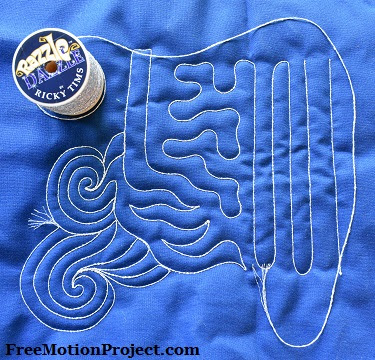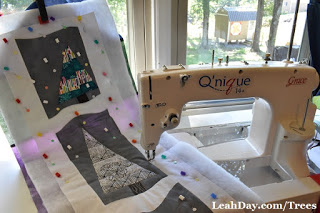Trying New Threads on the Grace Qnique 14+
This week our employee piecer and I have basted several Wonky Christmas Tree Quilts and I’m can’t wait to start quilting, but first I want to experiment with a new set of threads. I’ve pretty much stuck with my favorite Isacord thread on the Grace Qnique so it’s high time I try something new.
Instead of experimenting on a real quilt, however, I’ve pulled out a practice sandwich so I can make a big mess, take notes, and learn what it takes to use each new thread on the machine.
See how I try out each type of thread on the Grace Qnique table mounted longarm in this new quilting tutorial:
Click here to find more videos on the Grace Qnique 14+.
The threads tested in this quilting tutorial include Superior Threads Magnifico, Aurifil Lana wool, Aurifil 50-wt Mako cotton, Superior Threads So Fine, and Superior Threads Razzle Dazzle.

When winding each thread into the machine, I loosened the top tension completely so each thread would begin at the same starting point. Of course, this also meant each thread started with bad tension, but I think that’s a good thing. Better to start by making a mess first to get it out of your system!
As you saw in the video, I had trouble with the Aurifil threads breaking and tried troubleshooting by changing needles and slowing down as I stitched. I do think the Lana wool will work in the bobbin, and with more research into needle types it may work in the top of the machine as well.
It is important to note that my spools were fairly old so it could also be age that’s weakened the thread too. Yes, thread can go bad over time. Light, dust, and moisture can weaken thread and make it much more prone to breaking.
I store my threads in a pull out drawer to keep it safe from light and dust, but it’s still in the basement. Even with a dehumidifier running, the basement always stays a bit more moist than I think is good for my thread collection.
I also broke thread with the So Fine thread, but I do think that was caused by the speed I was running the machine. Some threads just can’t take the higher speeds a longarm or even some home machines can produce so it’s important to slow down and watch out for that.
Another note: the small amount of stitching to test these threads was only a starting point. Before quilting on a real quilt, I will likely fill two large practice sandwiches to be 100% sure of the tension and to watch for things like skipped stitches and thread breaks at high speed which often don’t show up until I get comfortable.

As you can see, testing threads is a slow process, and you have to be willing to experiment and have patience as you adjust tension and keep checking the front and back of your quilt. It’s not a speedy process. This is one of the reasons why I mostly quilt with my favorite Isacord thread for almost everything because it takes time and energy to test new threads, troubleshoot issues, and discover all the quirks about a new thread.
When you do want to change it up, always test on a practice sandwich. I created my practice quilt using cotton fabric and the same batting I’m using in the Wonky Christmas Tree Quilts.
By using similar materials to the real quilt, the threads should behave the same so whatever the stitches look like on the practice sandwich, they will look just as nice on the real quilt.
Bobbin thread work is lots of fun and I love the extreme punch of texture the thicker threads like Razzle Dazzle add to the quilt. If you like to learn more about bobbin work on your home machine please check out the Waterfall Bargello Workshop. No matter which machine you use, this is a terrific technique to master!
The scary thing about bobbin thread work is quilting the quilt from the back and not being able to see what’s happening on the front of the quilt. To prepare the quilt, I like to stitch in the ditch from the right side so I have an outline of the pieced shapes.
That way I know where the shapes are and can easily quilt around them with the back of the quilt facing up.
It was scary to try thicker threads in my longarm machine. I think the reason I’ve avoided experimenting with new threads is fear of breaking my machine, but making this video helped me push past that. Sometimes the machine will run louder and the quilt will feel different to stitch. You just have to adjust and trust that the machine was built to do this and so much more.
You’re worried about trying different threads in your machine, try getting a second bobbin case. A second case will allow you to adjust the tension and experiment with thicker bobbin threads without adjusting the tension of your main bobbin case. That way you have the case you usually use for your favorite thread set aside, and a second case just for playing with weird threads.
So what do you think of all of these threads? Do you have a favorite thread you wish I’d test? Let me know in the comments below and I’ll continue trying new threads as I begin quilting the Wonky Christmas Tree Quilts.
Click here to find all the videos we’ve shared on the Grace Qnique 14+.
Let’s go quilt,
Leah Day



Leah, love this video – the practical approach to trying out different threads and documenting right on a quilting sample. I cant wait to try bobbin work!
I did find that when I used King Tut thread, had tension problems like crazy by using in both the top and bobbin. Then read a lot of blogs and Superior's thread guide and saw they recommended using their Bobbin thread or So Fine in the bobbin. Made a huge difference. I have used Aurifil 50wt in both my DSM and a sit down longarm without problems, but found the smaller the needle the better. Seems like bobbin tension had to be adjusted tho'. I Know several longarmers that use both So Fine 50wt and Aurifil 50wt, but they had a bobbincase tension adjustment for them (one says she bought a couple extra cases and keeps them set for her most frequently used threads – Isacord, Glkide 60wt, So Fine 50wt, and Aurifil 50 at, to save time – not cheap but she quilts for others, so its probably more efficient for her).
Again, thank you so much for the video – great ideas and fun to watch! Hope you are healed up from chigger bites.
Hi Keah. I've been reading you awhile and branched out a little on my quilting for the last quilt. I tried some things I saw here and am really happy with my improvement. Hope you'll pop by and take a look. My biggest goal was to quilt bigger and fill the space better. I felt like mission accomplished.
That's great! I checked it out and it's a beautiful quilt! Just keep quilting, playing, and trying new things because there's always something new to learn.
Thank you for sharing Julie! Yes, I think Superior Threads have a lot of interesting ways to balance different thread weights together. I plan to get more bobbin cases for exactly this reason. I'd rather keep up with three cases than memorize what tension to adjust them too.
Yep, the chigger bites have all healed (OMG that was bad!). Never, ever, want to do that again!